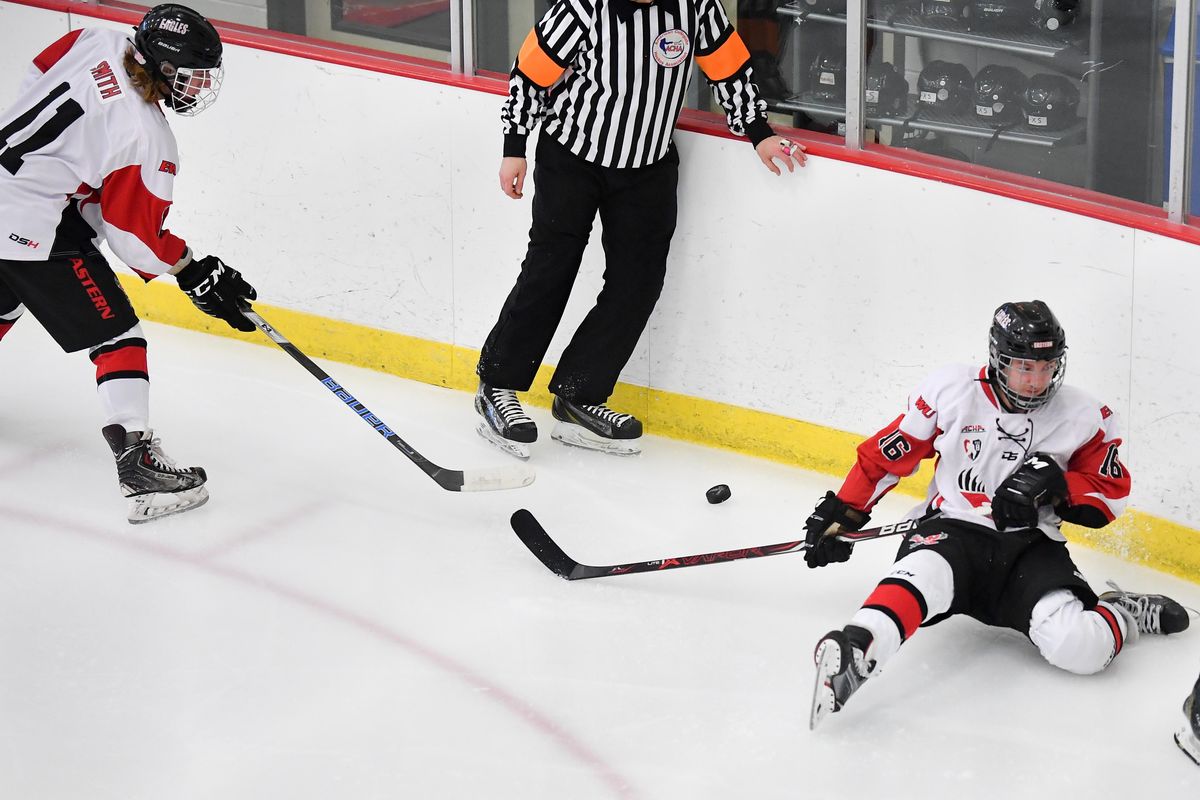Eastern Washington club hockey team gives players chance to compete, succeed at high level

CHENEY – After this season, goalie Tyler O’Donnell knows that this is about it for his hockey career.
O’Donnell is a senior with the Eastern Washington club program. He isn’t getting paid – he’s the one doing the paying – and won’t be paid to play anywhere else next year.
“I’m enjoying the ride while I can,” the geology major said. “I’m hoping to go somewhere with that degree, but right now – enjoy my last year.”
The Eagles’ hockey program took a big step up this season, the biggest in its existence: It accepted an invitation to join the PAC-8 Conference, which isn’t exactly what it sounds like. It houses only seven of the usual Pac-12 schools and five others associated with other conferences for other sports.
But the Eagles are amid their most successful season, ranked 17th of the 55-team western region of the American Collegiate Hockey Association, Division II.
While that’s not at the level of play of, say, the professional Spokane Chiefs of the Western Hockey League – the ACHA D-I would line up behind NCAA D-III in skill level – EWU’s program gives players like O’Donnell a chance to compete in a sport they love and still get an education.
Zac Mindermann attended East Valley High, served in the Marine Corps and was ready to go to college. He had previously played for the Spokane Jr. Chiefs and is a junior on the EWU team.
“I decided to come back here, be close to home, and it was a great fit and a great facility,” Mindermann said. “I can’t say no to this.”
Most players hail from Washington, including seven from Spokane. Including Mindermann, three played for the Jr. Chiefs, and a couple of others were once members of the Spokane Braves of the Kootenay International Junior Hockey League. A few, like O’Donnell and forward Taylor Bargar, came from California, which has tuition reciprocity with EWU.
That made it much more reasonable to come this way, because as a club sport, there are no scholarships. Each player pays $1,700 to cover travel, gear and other expenses – though, by practicing after 9 p.m., they don’t have to pay to use the on-campus rink, coach Pat Hanlon said. The team has sponsors and raises funds.
“We try to make it as affordable as we can,” Hanlon said.
Hanlon has been with the team for 10 years, since the arena was built, first as an assistant and now in his second year as head coach. Hanlon spent time in the Midwest as a coach before joining EWU. He has a day job at Rockwood Home Health.
EWU had two teams that played in separate leagues until this season, when they came together to compete in the PAC-8. One team – the better squad – played in a British Columbia league and the other in the ACHA.
As one team this year, the Eagles are 15-5-0 and will enter the PAC-8 tournament in February as one of the favorites to win, along with Boise State (16-5-1) and Oregon (12-3-1).
Even if they lose there, so long as they return to the top 10 of the rankings, they would be guaranteed a spot in the 12-team regional, because there are only two conferences large enough to earn automatic bids. The rankings identify the rest.
The Eagles nearly fill their 1,000-seat arena on Friday night games, Hanlon said, and their profile is gradually increasing.
“I think the key is we try to treat it like an NCAA program,” said Travis Allen, the EWU club sports coordinator who has worked in the Chiefs’ organization. “It feels like a varsity sport. We treat it that way. … We just elevate what we do higher than the normal standards.”
Gonzaga and Washington State both compete in ACHA D-II, but the Cougars come to Cheney to practice and play and the Bulldogs go to Eagles Ice Arena. WSU is in the PAC-8 but doesn’t play many nonconference games. WSU is 0-11-0 this year; Gonzaga is 0-2-0.
Being a PAC-8 member gives the Eagles more guaranteed games – they must play everyone in their six-team North Division at least twice – and a chance at that automatic bid to regionals in Lake Tahoe, California. It leads to a lot of long bus rides – no room in the budget for charter jets – and they play almost every weekend from late September to early March.
For now, this is a sustainable position for the program, and it has no immediate goals of climbing into the ACHA Division I or making a bid to join the NCAA.
“We’ve been fighting to get to that next level, and (when we) found out we were going to the PAC-8, it was huge,” Mindermann said. “It felt like I was really playing college hockey. … It’s gonna be crazy to see where it goes, and to know we were part of such solid beginning stages and putting ourselves on the map this year.”